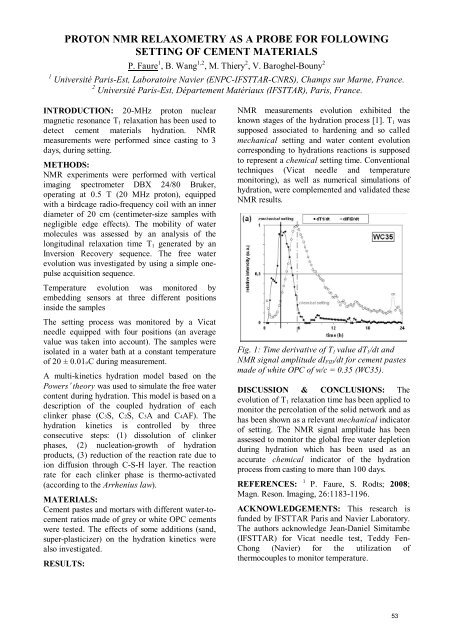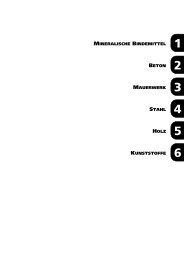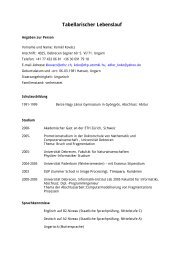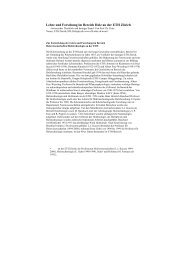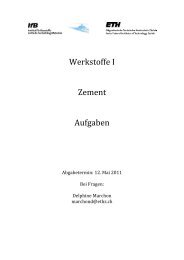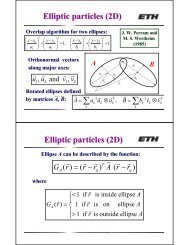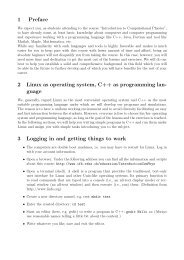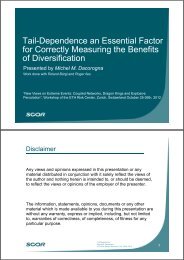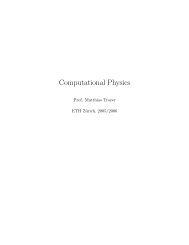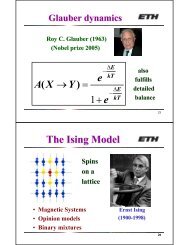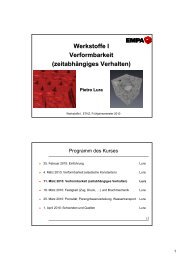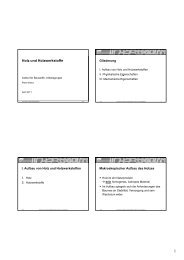Here - Institute for Building Materials - ETH Zürich
Here - Institute for Building Materials - ETH Zürich
Here - Institute for Building Materials - ETH Zürich
You also want an ePaper? Increase the reach of your titles
YUMPU automatically turns print PDFs into web optimized ePapers that Google loves.
PROTON NMR RELAXOMETRY AS A PROBE FOR FOLLOWINGSETTING OF CEMENT MATERIALSP. Faure1 , B. Wang 1,2 , M. Thiery 2 , V. Baroghel-Bouny 21 Université Paris-Est, Laboratoire Navier (ENPC-IFSTTAR-CNRS), Champs sur Marne, France.2 Université Paris-Est, Département Matériaux (IFSTTAR), Paris, France.INTRODUCTION: 20-MHz proton nuclearmagnetic resonance T 1 relaxation has been used todetect cement materials hydration. NMRmeasurements were per<strong>for</strong>med since casting to 3days, during setting.M<strong>ETH</strong>ODS:NMR experiments were per<strong>for</strong>med with verticalimaging spectrometer DBX 24/80 Bruker,operating at 0.5 T (20 MHz proton), equippedwith a birdcage radio-frequency coil with an innerdiameter of 20 cm (centimeter-size samples withnegligible edge effects). The mobility of watermolecules was assessed by an analysis of thelongitudinal relaxation time T 1 generated by anInversion Recovery sequence. The free waterevolution was investigated by using a simple onepulseacquisition sequence.Temperature evolution was monitored byembedding sensors at three different positionsinside the samplesThe setting process was monitored by a Vicatneedle equipped with four positions (an averagevalue was taken into account). The samples wereisolated in a water bath at a constant temperatureof 20 ± 0.01oC during measurement.A multi-kinetics hydration model based on thePowers’ theory was used to simulate the free watercontent during hydration. This model is based on adescription of the coupled hydration of eachclinker phase (C3S, C2S, C3A and C4AF). Thehydration kinetics is controlled by threeconsecutive steps: (1) dissolution of clinkerphases, (2) nucleation-growth of hydrationproducts, (3) reduction of the reaction rate due toion diffusion through C-S-H layer. The reactionrate <strong>for</strong> each clinker phase is thermo-activated(according to the Arrhenius law).MATERIALS:Cement pastes and mortars with different water-tocementratios made of grey or white OPC cementswere tested. The effects of some additions (sand,super-plasticizer) on the hydration kinetics werealso investigated.RESULTS:NMR measurements evolution exhibited theknown stages of the hydration process [1]. T 1 wassupposed associated to hardening and so calledmechanical setting and water content evolutioncorresponding to hydrations reactions is supposedto represent a chemical setting time. Conventionaltechniques (Vicat needle and temperaturemonitoring), as well as numerical simulations ofhydration, were complemented and validated theseNMR results.Fig. 1: Time derivative of T 1 value dT 1 /dt andNMR signal amplitude dI FID /dt <strong>for</strong> cement pastesmade of white OPC of w/c = 0.35 (WC35).DISCUSSION & CONCLUSIONS: Theevolution of T 1 relaxation time has been applied tomonitor the percolation of the solid network and ashas been shown as a relevant mechanical indicatorof setting. The NMR signal amplitude has beenassessed to monitor the global free water depletionduring hydration which has been used as anaccurate chemical indicator of the hydrationprocess from casting to more than 100 days.REFERENCES: 1 P. Faure, S. Rodts; 2008;Magn. Reson. Imaging, 26:1183-1196.ACKNOWLEDGEMENTS: This research isfunded by IFSTTAR Paris and Navier Laboratory.The authors acknowledge Jean-Daniel Simitambe(IFSTTAR) <strong>for</strong> Vicat needle test, Teddy Fen-Chong (Navier) <strong>for</strong> the utilization ofthermocouples to monitor temperature.53


